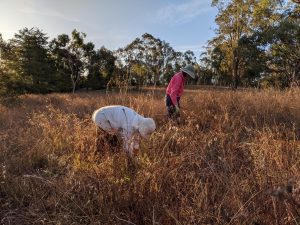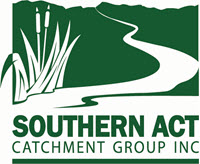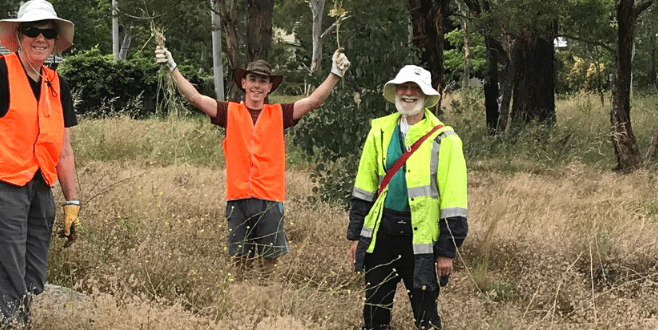Southern ACT Catchment Group works with our member groups on landcare and parkcare projects which promote community stewardship and improve our environment- often with the support of government grants.
Below are some examples of current and completed projects.
- Holder Landcare Revegetation
- Kambah Grasslands Gibbs Place/Little Taylor
- Pink-tailed worm lizard habitats in Tuggeranong
- Storyboards in Holder Wetlands
- Erosion Control and Upkeep at Cooleman Farm Park
- Red Hill Herbaceous Weed Control
- Improving Safe Access to Weston Creek orchard
- Featherstone Gardens Screen Planting
Holder Landcare Group (HLG) have been undertaking habitat restoration in a 1600sqm area at the Stapylton Street end of Bill Kennedy Memorial Park (BKMP), Holder. The remnant vegetation within BKMP is a degraded patch of Blakely’s Red Gum – Yellow Box tall grassy woodland where a few significant hollow bearing eucalyptus trees have been identified. Prior to these Landcare activities there was little understory and a lack of native grasses and groundcovers, the group has successfully reinstated a grassy woodland ecosystem to part of this park. This project builds on the groups effort and will protect and restore another 350sqm of degraded Blakely’s Red Gum – Yellow Box tall grassy woodland in BKMP. Project activities aim to protect the existing mature trees and reintroduce resilient understorey species therefore reducing the need for ongoing maintenance of the site. The work undertaken in this grant will include reduction of invasive grass species and reintroduction of a native understorey to the site while protecting the drip line of existing mature and hollow bearing trees.
The importance of grassy woodland patches in our suburbs and the work of the Holder Landcare group will be showcased in an interpretive sign designed to improve community engagement and increase neighbourhood knowledge of the environmental values of the grassland.
This project is delivered with assistance from the ACT Government under the 2022-2023 ACT Environmental Grants Program.
This project will raise the community understanding of the environmental values of the Gibbs Place/Little Taylor Grassland in Kambah and engage the local community in its care. As a remnant Brittle Gum Open Forest – Box Gum Woodland, which supports a very healthy and diverse grassland community, this patch provides an important connection through to Mount Taylor. Activities will include enhancement of the healthy and resilient patch of native grassland through plantings and harnessing local interest to form a new urban Landcare group to

continue maintenance on the site to increase native habitat in the urban landscape. With few such ecologically valuable grassland sites in Tuggeranong, SACTCG are keen to protect those patches that remain. Weed incursion issues will be treated through a qualified contractor to reduce competition to native plants from species such as African Lovegrass. Community education will raise the profile of this park and will include the design and installation of an information sign about the importance of retaining such valuable native patches within our suburbs. A pamphlet will be developed for letterbox drops to educate the surrounding neighbourhood about the role of small pocket parks in urban habitat and species such as Kangaroo Grass in fire management within our suburbs.
This project will be delivered with assistance from the ACT Government under the 2022-2023 ACT Environmental Grants Program.
SACTCG worked with Friends of Tuggeranong Hill and Farrer Ridge ParkCare Group to protect Pink-tailed-Worm lizard (Aprasia parapulchella) populations on Tuggeranong Hill Nature Reserve and Farrer Ridge. This project included the treatment of invasive plants impacting on significant habitat patches in line with the ACT Action Plan for the species, the Canberra Nature Park Draft Reserve Management Plan 2019 and the Osborne W and Wong D 2012 case study on the long term survival of Pink-tailed –Worm lizard on Mount Taylor Reserve. Significantly this project built on the work of two previous SACTCG projects on Mt Taylor to protect stronghold populations of Aprasia parapulchella and facilitating a wholistic approach to protecting this habitat in the southern system of reserves in Canberra Nature Park. Key activities undertaken on Tuggeranong Hill were the removal of pest plants invading the edges of this high and medium quality habitat and treatment of early incursions of African Love Grass (ALG) along walking and fire trails running within and along the habitat edge preventing greater incursions of this weed into the reserve. Friends of Tuggeranong Hill and Farrer Ridge ParkCare Group provided significant in-kind contributions in the form of advice, ongoing monitoring of areas as well as removal of pest plant regrowth. They also undertook hand removal of weeds in the Pink-tailed Worm-lizard habitat and planting of understory plants and grasses for species regeneration and preservation.
This project was delivered with assistances from the ACT Government under the 2021-2022 ACT Environment Grant Program.
This project is to design and install educational and engaging signs at the Holder Wetlands. The goal is to encourage the community to step off the footpath that simply goes through the wetlands, to instead walk around and between the wetland pools, to take the time to consider the different environmental components of the wetlands and to engage with the wetlands site. The signs will help to connect the community to the wetlands site and foster stewardship. Each sign will focus on an aspect of the wetlands, e.g. the birds and frogs that may be spotted, the plants in the wetlands, the trees, the river etc. Signs will also be included about the history of the site, including the pine forest and the bushfires, and the traditional custodians.
Signs will reference to the Holder Wetlands Urban Landcare Group to encourage new people to join the group and build awareness of the work of the group.
This project is run with the assistance of the ACT Government under the 2022/2023 Adopt-A-Park Community Grants Program.
The long term goals of the Cooleman Farm Neighbourhood Park Volunteer Group (CFNPVG) is to develop an aesthetically pleasing, resilient landscape which provides wildlife connectivity, diverse habitat and a variety of spaces for intergenerational recreation and education. The park will be developed into a multi-age diverse usage community environmental hub. To achieve these goals this project activities includes:
- Native plantings
- Rocks for habitat and erosion control
- Path improvements
This project will provide initial plantings to supplement those which will be undertaken by the ACT Tree Unit in May 2022. The plantings will be within a series of “islands-mulched beds” strategically planted throughout the park. The focus of these plantings will be bird and butterfly friendly shrubs, grasses and ground-covers. The plantings will include Blakey’s Redgum and Yellow Box to create nesting hollows for the future as well as species to create shade and habitat. Shrubs, grasses and groundcovers will be primarily local species naturally found in Red Gum - Yellow Box woodland communities. There will also be a focus on plants used by the Traditional Owners for, food, fibre, medicine, shelter and defence. Rocks will be purchased and placed within these islands to mitigate erosion and provide habitat. Paths will also be designed through the islands enabling volunteers to undertake regular weeding and maintenance.
This project is run with the assistance of the ACT Government under the 2022/2023 Adopt-A-Park Community Grants Program.
Red Hill is regarded as a high-quality biodiversity reserve within the ACT, and home to a number of significant species. Horehound, which is present in high densities this year, is a threat to suitable habitat for Superb Parrots, Gang gangs, Small Ant Blue butterflies (critically endangered) and their host species, Coconut Ants. ACTMAPi shows that the project area also has populations of Hoary Sunray, Button Wrinklewort, and other identified rare plants. The control of Horehound in this area will facilitate the reestablishment of native species, decreasing competition and improving the ecological complexity of the site. Over sowing of native groundcover and planting of native shrubs will increase the biodiversity of the treated area, reduce future invasive plant incursions and provide more food and habitat to the diverse a range of native species in the reserve.
Activities within the project consisted of:
- Herbicide treatment, initial and follow-up by a qualified and experienced contractor.
- Over sowing of an appropriate competitive native grass/ forbes mix.
- Planting of understory native species in the treated areas.
- Hand-weeding by the ParkCare group to remove smaller isolated patches of weed and where there is risk to significant plants.
This project is delivered with assistance from the ACT Government under the 2021-2022 ACT Environment Grant Program.
Weston Creek Orchard Volunteer Group, as a TCCS registered group, has worked on the site for many years. Currently the site is bounded by a barbed wire fence, which is old and broken in areas along the perimeter, so provides no security to limit access to the site. Volunteers are aware of access by unknown cars and individuals who regularly leave behind rubbish and at times drug paraphernalia. The fence directly in front of the orchard does not require replacement, the barbed wire fence of concern is directly in front of the woodland patch adjacent to the orchard, which kangaroos regularly get caught in. Along Unwin street, the side open to the road is where volunteers need to enter and currently lacks proper pedestrian access. As such visitors presently enter the site by climbing over the barbed wire fence. Whilst there is only vehicle access to the lower part of the site, a second gate further along to provide access to the highest part of the orchard would be beneficial.
This project will improve access through the removal of the barb wire fence and the addition of:
- Pedestrian access gap - improve easy access to pedestrians without having to climb through barb wire.
- Gate for vehicle access for delivery of water, mulch and other materials to the highest point of the orchard, requiring less energy, effort and time to move materials around the orchard.
- Removal of hazardous barb wire that poses a hazard to people trying to access the orchard and to local fauna (particularly kangaroos) that move about the area.
- Installation of bollards to prevent unauthorised vehicle access to both the orchard and native wood land around the orchard while allowing access to walkers and volunteers.
This project is run with the assistance of the ACT Government under the 2022/2023 Adopt-A-Park Community Grants Program.
In this project SACTCG will work with Fetherstone Gardens Friends to plant a native corridor at the frontage of Featherstone Gardens to provide a windbreak for the garden on the exposed southerly border, building on the native species already present on the garden grounds. The planting will also help develop a tree canopy to an open part of Weston, providing a cooling effect to the road and the surrounding homes and improving the habitat and food source for local native birds and animals. This project builds on the work of the Featherstone Gardens Friends in caring for an important urban garden in Weston Creek that includes an arboretum, woodland garden, native garden, and “secret garden”. This work is also heavily supported by Weston Creek Community Council who value this green landscape in the urban environment.
The project focusses on the land along Heysen street, along the frontage of Fetherstone Gardens. This area is primarily weed plants, including those on the ACT weeds list, such as privet, cotoneaster and blackberry, with some eucalypts. The removal of these weeds will reduce the seed spreading, potentially entering sites such as the Holder Wetlands, woodland patches along the Tuggeranong Parkway and Oakey Hill. The project will consist of:
- Removal of weed plants by volunteers along 100 metres of fenceline.
- Planting of 150 shrubs, saplings and groundcovers along 100 metres of fenceline.
This project is delivered with assistance from the ACT Government under the 2021-2022 ACT Environment Grant Program.
See our other projects at the pages below:


